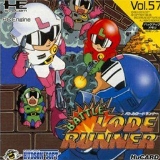
Battle Lode Runner
Encyclopedia
Battle Lode Runner is a video game based on the Lode Runner
series of games, originally released for the NEC
PC Engine
by Hudson Soft
in 1993. It was released in Japan on May 29, 2007 and also released in the North American and European regions for the first time in April 2007 for the Wii
Virtual Console
. It is also the first game originally released only in Japan to be available on the Virtual Console for another region.
The game is an excellent example of the trap-em-up genre, which also includes games like Heiankyo Alien
, Boomer's Adventure in ASMIK World
, and Space Panic
.
Lode Runner
Lode Runner is a 1983 platform game, first published by Brøderbund. It is one of the first games to include a level editor, a feature that allows players to create their own levels for the game. This feature bolstered the game's popularity, as magazines such as Computer Gaming World held contests...
series of games, originally released for the NEC
NEC
, a Japanese multinational IT company, has its headquarters in Minato, Tokyo, Japan. NEC, part of the Sumitomo Group, provides information technology and network solutions to business enterprises, communications services providers and government....
PC Engine
TurboGrafx-16
TurboGrafx-16, fully titled as TurboGrafx-16 Entertainment SuperSystem and known in Japan as the , is a video game console developed by Hudson Soft and NEC, released in Japan on October 30, 1987, and in North America on August 29, 1989....
by Hudson Soft
Hudson Soft
, formally known as , is a majority-owned subsidiary of Konami Corporation is a Japanese electronic entertainment publisher headquartered in the Midtown Tower in Tokyo Midtown, Akasaka, Minato, Tokyo, Japan, with an additional office in the Hudson Building in Sapporo. It was founded on May 18, 1973...
in 1993. It was released in Japan on May 29, 2007 and also released in the North American and European regions for the first time in April 2007 for the Wii
Wii
The Wii is a home video game console released by Nintendo on November 19, 2006. As a seventh-generation console, the Wii primarily competes with Microsoft's Xbox 360 and Sony's PlayStation 3. Nintendo states that its console targets a broader demographic than that of the two others...
Virtual Console
Virtual console
A virtual console – also known as a virtual terminal – is a conceptual combination of the keyboard and display for a computer user interface. It is a feature of some operating systems such as UnixWare, Linux, and BSD, in which the system console of the computer can be used to switch between...
. It is also the first game originally released only in Japan to be available on the Virtual Console for another region.
Gameplay
Like other games in the Lode Runner series, Battle Lode Runners gameplay revolves around traveling through 11 different time periods, collecting gold without being caught by many creatures. Your character can climb ropes and ladders, walk on top of enemies, collect power-ups, and most importantly, dig a hole on the right or left of himself. In some versions you can set traps, but Battle Lode Runner doesn't contain this feature.The game is an excellent example of the trap-em-up genre, which also includes games like Heiankyo Alien
Heiankyo Alien
is a video game created by the University of Tokyo's Theoretical Science Group in 1979. The game was originally developed and released as a personal computer game in 1979, and was then published by Denki Onkyō Corporation as an arcade game in January 1980...
, Boomer's Adventure in ASMIK World
Boomer's Adventure in ASMIK World
Boomer's Adventure in ASMIK World, known in Japan as is a Game Boy video game from Asmik copyrighted in 1989; Asmik of America Corp. copyrighted its version in 1990....
, and Space Panic
Space Panic
Space Panic is a 1980 arcade game designed by Universal, which Chris Crawford calls the first ever platform game, as it pre-dates Nintendo's Donkey Kong which is often cited as the original platform game. Space Panic lacks Donkey Kongs jump mechanic, disqualifying it as a platformer for some...
.

